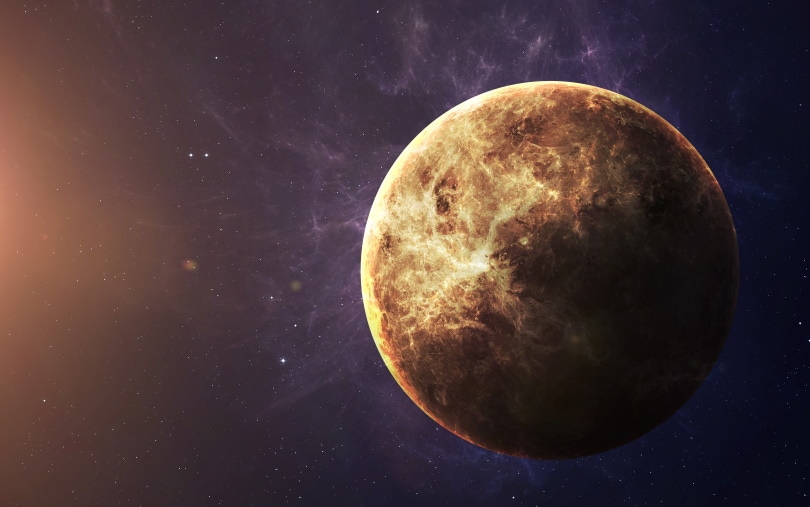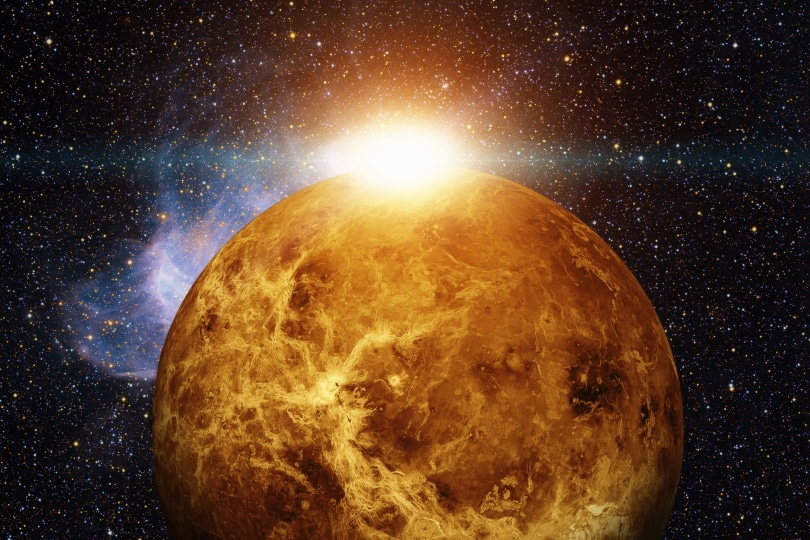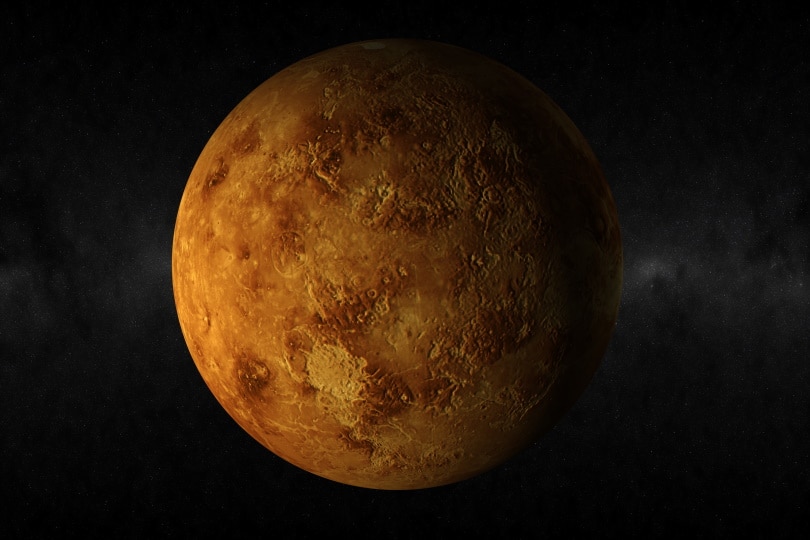How Hot Is Venus? Is it the Hottest Planet?
Last Updated on

Venus, also referred to as “Earth’s evil twin,” is our closest planetary neighbor and the second planet from the Sun. Venus is characterized by a dry, volcanic landscape with highly-reflective clouds of sulfuric acid and a dense, soupy atmosphere that is a death trap for any creature or spacecraft brave enough to enter its volatile environment.
With ferocious hurricane-force winds, violent thunderstorms, raging showers of sulfuric acid, and temperatures hot enough to melt lead, tourists won’t be visiting Venus anytime soon.
Venus is so deadly that only one spacecraft has made it to its surface, Russia’s Venera 13 lander. However, Venus’ wrath proved to be too much, with the spacecraft only surviving for a mere 127 minutes. Overwhelmed by a runaway greenhouse effect, Venus averages at a temperature of 847°F and serves as a cautionary tale of carbon-accelerated climate change.

Why Is Venus Hotter Than Mercury?
Venus is extremely hot and a death trap for anything that dares to enter its domain. Interestingly, Venus should not be as hot as it is. However, a perfect storm of hellish conditions has turned it into a nightmare planet. Even though Mercury is the closest planet to the Sun, Venus’ surface temperature is almost double Mercury’s, with an average of 847°F recorded across the planet. This goes against all intuition and makes an average day on Mercury seem balmy, with medial temperatures around 354°F.

The Atmosphere
The major accelerator of Venus’ fiery depths is its extremely thick and dense atmosphere. With clouds of carbon dioxide and sulfuric acid, Venus is the victim of a runaway greenhouse effect that causes heat from the Sun and planetary surface to become trapped. The high density of the atmosphere also leads to air pressures nearly 95 times greater than what is found on Earth’s surface. Since pressure and temperature are directly proportional, this does not cool things down at all. Standing on the surface of Venus is the equivalent of standing on the bottom of an ocean over half a mile deep and would make swimming through yogurt sound easy.
On the other hand, Mercury has an extremely thin exosphere that essentially exposes it to the vacuum of space. Mercury’s only protection from the harsh expanses of space is the thin layer of atoms blasted off its surface by wind, asteroids, and solar radiation. Mercury is also significantly smaller than Venus, which means it has a much weaker gravitational pull that isn’t ideal for retaining an atmosphere. This makes it challenging to hold onto heat as much of it radiates back into space.

The Albedo
Albedo is a measure of how reflective an object is and quantifies how much incoming sunlight is reflected back to space versus how much is absorbed. An object’s albedo is rated on a scale of 0 to 1, with a score of 0 signifying a perfect blackbody that absorbs all incoming light. Objects with high albedos, such as snow and clouds, are really good at reflecting incoming light and generally appear bright.
Venus has a very high albedo of 0.90, meaning it reflects 90% of the light that hits it. This is nearly 8 times greater than Mercury’s albedo, which is about 0.119. However, against all odds, Mercury is still much cooler than Venus despite absorbing more heat and receiving more solar energy per unit of surface area. The big difference is Venus’ thick, soupy atmosphere, which holds onto the small fraction of absorbed heat and struggles to let it go. Mercury, on the other hand, absorbs much of the light that hits it. However, its thin and virtually nonexistent atmosphere makes it incredibly difficult for Mercury to hold onto any of it.

The Orbit
Venus rotates about its axis at a much slower rate than Mercury, consequently spending a longer time in the Sun. Days on Venus are incredibly long, and the equivalent of a Monday at work on Venus would last 243 Earth days. This allows Venus to bake under the sun like a rotisserie chicken for about 100 Earth days, contributing to its inferno-like temperatures. Mercury, however, rotates significantly faster, taking just 59 Earth days to complete a day cycle and spending little time bathed in the Sun’s rays.

Summary
Venus is a planet of extremes that defies all reasonable expectations. With a thick atmosphere composed of carbon dioxide and sulfuric acid, Venus is controlled by a runaway greenhouse effect that increases its temperatures by over 700°F. Venus also basks in the Sun for a significant portion of its day, contributing to its hellish temperatures and making it the hottest planet in our solar system. With average temperatures of 847°F, Venus easily wins first prize for the most hellish planet, especially since it’s hot enough to melt lead and able to overpower even the toughest of spacecraft.
Featured Image Credit: Vadim Sadovski, Shutterstock
About the Author Laura Guziczek
Laura Guziczek is from New York City and an aerospace engineer by day, freelance writer by night. Although she is always moving around, Laura is currently based on Florida's sunny Space Coast, where she attends graduate school. Her passions and hobbies include astrodynamics, rocketry, spaceflight, planetary science, cooking, music, and art, making her a great fit here at OpticsMag! When she's not working, you can frequently find her traveling, honing her cooking skills, thinking about space too much, and hanging out with her friends and dogs.
Related Articles:
Binocular Magnification Chart: Numbers & Distances Compared
What Is the Best Binocular Magnification for Hunting? Optical Features Explained
When Were Binoculars Invented? History, Today & Future
15 Crucial Facts About Ultraviolet Rays & the Sun
What Constellation Is Spica In? The Interesting Answer!
10 Interesting Leo Constellation Facts, Myths, and FAQs
15 Interesting Pegasus Constellation Facts, Myths, and FAQs
6 Interesting Sagittarius Constellation Facts, Myths, and FAQs in 2024!
